Thanks to the device attached to the sailfish, scientists recorded its hunting process of tuna at a maximum speed of 3.1 m per second.

Sailfish equipped with a tracking device. (Photo: Guy Harvey Research Institute, Nova Southeastern University).
A research team at Nova Southeastern University (USA) attached a camera to the sailfish (Istiophorus platypterus), a species considered by most experts to be the fastest in the ocean, and recorded its hunting process, as reported by IFL Science on February 21. This is the first time in the world that scientists have obtained footage of a sailfish hunting alone from its own perspective. The new study was published in the journal Scientific Reports.
Sailfish are renowned for their strength, unique appearance, and high-speed hunting behavior. However, experts have understood very little about how solitary sailfish hunt, primarily due to their elusive nature.
Footage of the sailfish hunting tuna. (Video: IFL Science)
The sailfish exerted considerable effort to catch tuna. The tuna even tried to conceal itself by swimming close to the sailfish, avoiding detection by the predator. The video did not capture the moment the sailfish caught the tuna (as the angle did not show the sailfish’s mouth), but after 60 seconds, the sailfish performed a “head shake.” Researchers believe this movement usually indicates swallowing or processing prey, suggesting that the sailfish successfully hunted.
The sailfish is regarded by many experts as the fastest fish in the world, with a maximum speed of about 8.2 m per second, but the individual monitored by the research team at Nova Southeastern University only reached a maximum speed of 3.1 m per second during the tuna chase. The team believes that pursuing tuna at a lower speed allows the predator to be more maneuverable and agile, rather than swimming too fast and failing to keep up with the prey’s directional changes.
In this new study, scientists provided the first footage of a sailfish hunting alone, over 24 hours of behavioral data, and estimates of metabolic rates. “This research enhances our understanding of the mysterious life of this ecologically and economically important fish species. Such knowledge is crucial for helping us better protect this species,” said Dr. Mahmood Shivji, co-author of the study and director of the Guy Harvey Research Institute at Nova Southeastern University.


















































